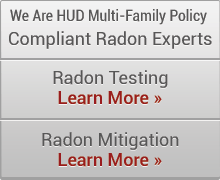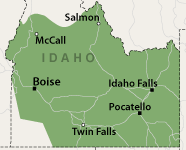
Soil Vapor Intrusion and How to Mitigate It
We Help Improve The Indoor Air Quality of Idaho Homes

VOCs in contaminated soil and groundwater plumes can enter buildings just like radon gas: through cracks in the foundation and openings for utility lines. Atmospheric conditions and building ventilation may drive vapor intrusion.
Most people understand that radon is a naturally occurring hazardous gas that, if detected, should be mitigated (vented to the exterior atmosphere before it can enter the living area of your home). What many homeowners do not know is that radon isn’t the only gas that may be entering your building from soil and groundwater underneath the home. Pollution can enter homes through a process called vapor intrusion, too.
The Environmental Protection Agency (EPA) recognizes 40 different volatile organic compounds (VOCs) based upon 18 indoor air studies. VOCs are gases, emitted from solids or liquids, some of which have short and long-term adverse health effects. They include industrial waste compounds, such as benzene, carbon tetrachloride, chloroform, and vinyl chloride.
How pollution can contaminate indoor air
Houses typically have a slightly negative air pressure. This may be due to natural convection (warm air rising and escaping from upper levels), ventilation without adequate fresh air makeup, and/or the effect of wind as it blows past a house, creating a vacuum on the leeward side and drawing indoor air along with it.
When a house has negative pressure, it will naturally attempt to equalize the pressure by drawing air into the house. Most of the replacement air comes from the outdoors through gaps around doors and windows. Some of it, however, may come up through cracks and holes (such as those made for plumbing, sump pumps, and electrical cables) in the foundation. Soil is very porous and filled with air pockets, so there is plenty from which to draw.
It is this latter source of air leakage that is worrisome. If pollutants in the ground or in groundwater sources produce vapors, they can easily be drawn into the home. Many of these pollutants are known or suspected carcinogens or the cause of a variety of respiratory diseases.
Vapor intrusion mitigation by National Radon Defense
The same methods used to mitigate radon may be used to remove soil vapors from below basements or foundation slabs before they enter a home. The international National Radon Defense network has worked with environmental engineering firms all over North America to finely craft a soil vapor extraction system that can effectively keep your air clean.
Being a member of the National Radon Defense, we have exclusive access to their state-of-the-art distribution center, which inventories all the radon fans and accessory items needed for a custom vapor intrusion system. The contractor network of radon mitigation companies we're a part of is North America’s most trusted source for vapor intrusion mitigation services.
We can help you decide whether a system based upon sub-slab depressurization (using a small fan to vent vapors to the outdoors), a passive approach (basement sealing), or a combination of systems is right for you. We also perform detailed pressure field testing to ensure the systems are working effectively.
For vapor intrusion mitigation, work with a company that has the experience to get the job done right. Contact National Radon Defense today for a free vapor mitigation cost estimate to get your home back to a safe and healthy environment for your family.
Contact us today for a quote for vapor intrusion mitigation. We are also your resource for radon testing!
Looking for a price? Get a no cost, no obligation free estimate.


